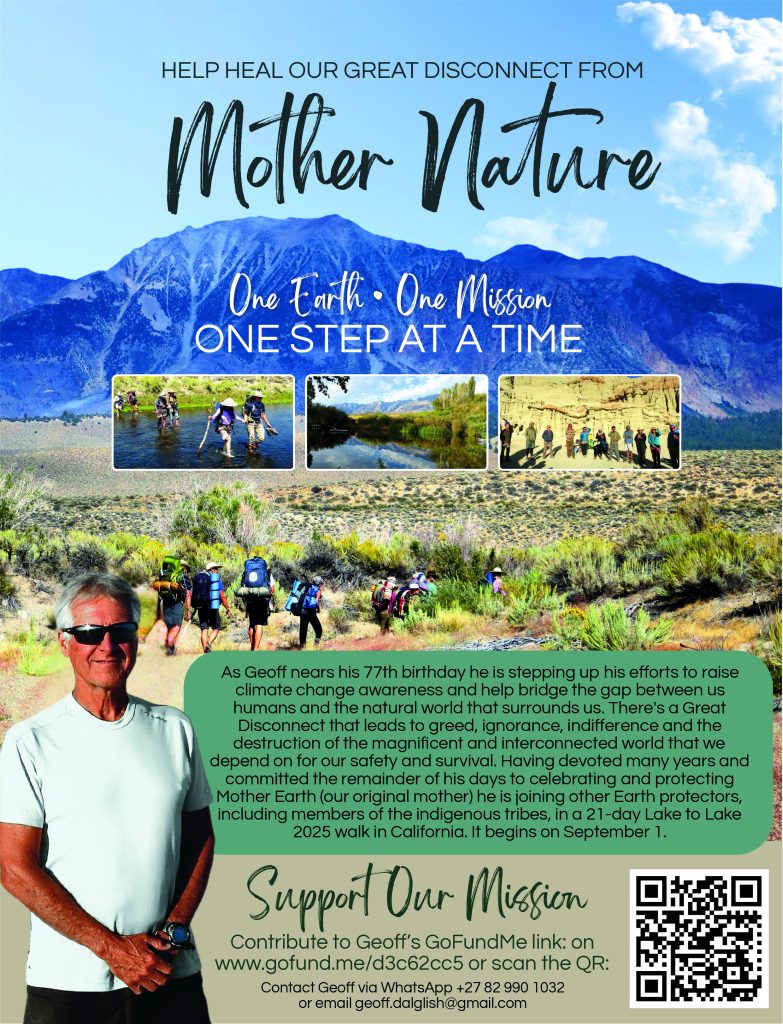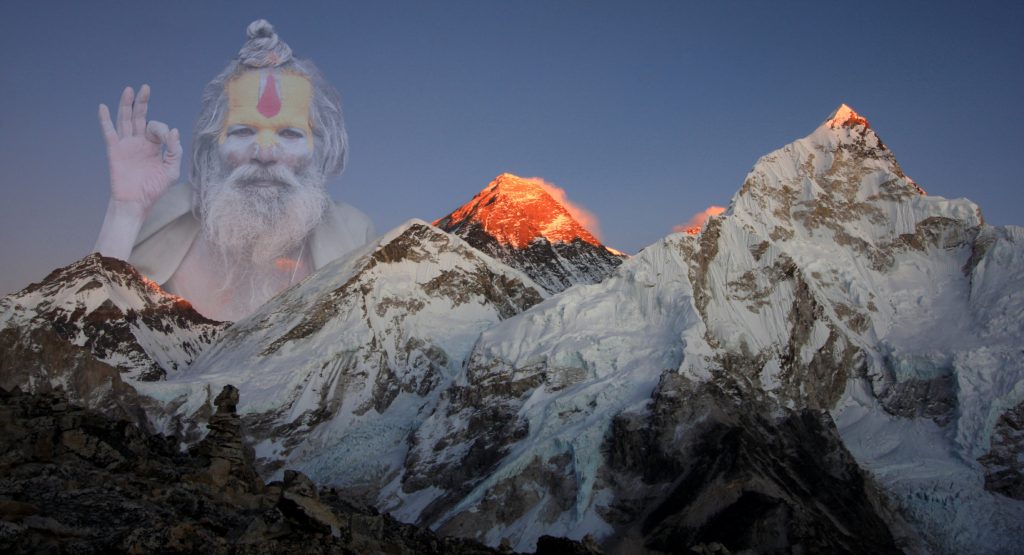Looking Back
Odyssey’s Pilgrim at Large, Geoff Dalglish, discovered more than lofty mountain peaks and treacherous glaciers on his 16-day trek to Everest Base Camp in 2007.
God lives in the high mountains of the Himalayas of Nepal. The reminders of our precious connection to the Divine are to be found everywhere: from the gaily fluttering Buddhist prayer flags welcoming pilgrims, to the ancient monasteries, stone altars and carved rock tablets that speak of centuries-old devotion and reverence for life. Even the cheerful clinking of yak bells seems somehow to carry special messages, perhaps reinforcing the mantras of devoted monks and their time-honoured chants: ‘Om mani padme hum, Om mani padme hum…’
Then, of course, there is the breathtaking scenery itself. Who can fail to be stirred by such awesome landscapes? Each breath of crisp mountain air makes you want to sing with joy and gratitude at such bountiful blessings. Is there any place on Earth more stunning than the Himalayas, or any better spot to be alive?
Nepal might be one of the poorest countries on the planet but it is blessed with no fewer than eight of the 14 peaks that thrust above 8 000m into the atmosphere, the most famous of which is Everest, or Chomolungma, Mother Goddess of the World, as she is known to the Tibetans.
Treading ever higher along rocky Himalayan paths is a boyhood dream come true. Since attending a talk by Sir Edmund Hillary in Durban and then shyly asking for his autograph, I’ve fantasised about sharing that view from the summit, standing on the top of the world with no higher place to climb. I’ve read the books of courage, determination and disaster; studied the statistics too. The quest to reach the top of Everest took longer than putting a man on the moon, although at the latest count some 11 000 souls have committed to the ascent, 3 000 of them succeeding – an encouraging success rate of 29 per cent. But the dark side of the statistics is that at the time of writing 207 climbers had died with many of their bodies preserved by the icy cold where they fell, serving as graphic and chilling reminders of our mortality.
While I’ve secretly cherished the ambition to climb Everest, I decided that this would be a look-see, going to Base Camp at 5 364 metres via a 16-day hike that would immerse me in the Tibetan Buddhist culture of the region and also take in the beautiful turquoise Gokyu lakes and include a trek over the daunting Cho La Pass. How hard could this be, I argued with myself?
My closest comparison was Uhuru Peak, the 5 895m summit of Kilimanjaro which is normally reached in just over four days as part of a six-day expedition. So I’d have more time to acclimatise and build fitness, and wouldn’t be going quite as high. Easy, I imagined.
Accompanying me were friends Deon Ebersohn, a Cape Town journalist and former motor industry executive, Jen Newenham, an environmental consultant from Mpumalanga, Nepali guide Dibash Onta and porters Sudip Baral and Rajan Bishowkarma. The trio of locals are a lesson in cheerful optimism, good humour and amazing physical stamina.
Sherpa is the tribal name for the Himalayan people living in the mountains of Nepal and Tibet, rather than a job description, although ‘sherpa‘ is synonymous in the minds of most westerners with porters of incredible strength and courage who are seemingly immune to the debilitating and potentially dangerous effects of acute mountain sickness (AMS). Nothing could be further from the truth, we discover during a talk by volunteer doctors at a rescue post. A snap survey of this particular audience reveals that many of the sherpas are from the Kathmandu Valley or other low-lying areas and it is a documented fact that they also suffer altitude-related illnesses, although they invariably hide these for fear of losing desperately needed income for their families.
What is verifiable is that the legendary climbing sherpas have adapted better to altitude, their blood carrying more oxygen than is usual. But because of their prolonged exposure to risk while establishing safe routes for climbers to follow and lugging equipment to high camps, they too are crushed in avalanches, fall into crevasses or succumb to extreme exposure.
Perhaps the greatest contemporary local legend was Babu Sherpa who summited Everest 10 times by the age of 36 and spent a record 21 hours on the summit without oxygen, only to fall to his death while apparently taking a photograph at one of the lower camps. Whatever their genetic make-up, the sherpas are the real heroes, selflessly devoting their lives to realising the dreams of their clients while supporting their families. For them it is not a recreational pursuit, but a practical necessity.
To the sherpas mountains are not obstacles to be conquered but living things to be treated with deep respect. Often we felt humbled by the cheerful good nature of the locals, despite living in such extreme climactic conditions. It is easy to understand how Edmund Hillary was so touched by his climbing companion Tensing Norgay and the deep spirituality of his people despite their grinding poverty. Since the two stood together on the top of the world on May 29, 1953, New Zealander Hillary has devoted much of his formidable energy to improving the lot of local people by helping to build and fund the creation of schools, clinics and hospitals, as well as the dramatic 450m short runway at Lukla.
Now around 88-years-old, he is revered by Nepalis as living proof that one man can indeed make a towering difference. As each day unfolds I celebrate my strengthening muscles, feeling the flab fall off me, although I too am touched by AMS, suffering minor headaches, nausea, sleeplessness and loss of appetite. Once I awake with a start, feeling panicked and realise that I had momentarily stopped breathing.
A long night stretches ahead of me facing my fears. I was an asthmatic as a child and having my oxygen levels reduced to little more than half by altitude is troubling enough, although nowhere near as scary as the idea of not breathing at all – even for a couple of seconds.
I put my absolute trust in the process of life, visualise positive outcomes and eventually quiet my fears. Dawn is a magnificent reward, another stunning day making a mockery of my night-time fears and imaginings.
Two books are keeping me company on my odyssey: The Autobiography of The Dalai Lama, Freedom in Exile, and Left for Dead, the account of American Beck Weathers and his horrific part in the 1996 tragedy when eight climbers died in a killer storm high on Everest.
I’m tormented by both volumes.
Each day as I trek higher, but always secure in the knowledge that modest lodgings and good food await me, I think of the Tibetan exiles who continue to flee the Chinese occupation and religious persecution in their own country.
Many have to walk in fear for days and weeks, often while poorly prepared and equipped for high-altitude conditions. Many are monks and nuns, while a number of the freedom-seekers are children as young as six or seven.
Depending on your viewpoint this expedition could be the ultimate gift and life-changing experience, or your worst nightmare in the bleakest and most hostile environment imaginable.
Their most usual destination is Dharamsala, home of the Dalai Lama and Tibetan government-in-exile in India, although exiles also enter Nepal, among them traders who cross the border illegally to sell their wares in settlements like Namche Bazar and Tengboche.
Outside the famous Tengboche monastery I watch monks bartering with Tibetans who have walked for several days to sell their cheap Chinese-made clothing. A story is circulating of seven of their kin shot dead recently by Chinese border guards and one senses a great empathy for people who are willing to take such risks for a few rupees.
In contrast with the human rights abuses across the border, the Buddhist message of love, peace and respect for all life is everywhere around us. Many of the places we stay in feature shrines and posters of His Holiness, the Dalai Lama, along with scenes from Tibet and some of our hosts are of proudly Tibetan origin.
It seems especially sad that genocide, torture and extreme religious persecution has been practised on a formerly peace-loving nation and I’m struck by the gentleness of all who I meet. Not once during my 16-day trek do I hear a local voice raised in anger or recrimination, although we do have to endure one obnoxiously loud American woman trekker and a group of drunken Koreans who show no respect for their fellow travellers.
Is it karma that causes the Koreans to miss their international flight out of Nepal? We try not to gloat or be judgmental.
Thinking of the brutality of the Chinese towards the Tibetans, who are now a minority race in their own country, I’m reminded of the Dalai Lama’s comment that his Chinese brothers and sisters are not bad people, but just people behaving badly.
Walking for 16 days allows plenty of time for introspection, along with a deep appreciation for the opportunity to step back in time to an almost medieval lifestyle. Not once do I see any form of motorised transport or even a wheel: No cars, motorcycles, bicycles or wheelbarrows in sight. Instead everything is carried on the backs of humans, yaks and the dzopkios that are a cross between a yak and a cow.
We marvel at the realisation that we are witnessing a hotel being carried into the Himalayas in pieces, which also explains why the sound-deadening is so abysmal in the overnight hostelries – how could it be otherwise with lightweight plywood panels for walls.
Seemingly small things like a hot shower are really appreciated. In Kathmandu a bottle of mineral water costs 15 rupees or around R1.65, the price soaring 20-fold to 300 rupees in the remoter regions of the Himalayas. And while a good meal can cost as little as R20 this won’t pay for a hot shower as you get closer to Everest Base Camp. My record is nearly R40 for that simple joy.
Often the water has to be carried several hundred metres from a nearby stream and then heated using dried yak dung. So nothing is easy.
Electricity is also a precious commodity, the meagre illumination during our overnight stays invariably provided by solar panels and then only when there have been a few hours of sunlight.
A battery-powered Petzl head torch is essential gear along with a down sleeping bag, warm trekking clothes, an inquiring mind and a keen sense of humour.
We encounter mist, rain, sleet, snow and biting winds, but on the days when it really matters we celebrate views of Everest and other legendary peaks like Nuptse, Lhotse and Ama Dablam in perfect sunshine.
Highlights include the breathtaking view from Goko Ri across a wide glacier towards Everest, as well as the ascent of Cho La Pass in deteriorating weather conditions. It is one of the toughest hikes I’ve yet experienced and constantly fraught with the danger of slipping on ice or snow-covered rocks and boulders. The pass was closed just before our arrival, and again after the brief window of opportunity with which we were blessed before fresh snowstorms.
On the top I was staggering with exhaustion as I trudged through deep snow in the gloom, slipping and falling more than once. But my spirits soared and I felt so incredibly alive – this is the kind of dramatic Himalayan landscape I’d dreamed of and the sort of physical challenge I relish.
The guidebooks and some friends had warned me that Base Camp might be an anti-climax, lacking a meaningful view of Everest.
I put my absolute trust in the process of Life, visualise positive outcomes and eventually quiet my fears. Dawn is a magnificent reward, another stunning day making a mockery of my night-time fears and imaginings.
But I was energised and exhilarated by the experience of trekking along the edge of the Khumbu Icefall and Glacier, at last coming face-to-face with that giant conveyer belt of rock and ice that forms one of the daunting obstacles to any summit attempt.
The main weather window happens in May each year, allowing a few teams a crack at the top when the notorious jetstream is not howling off the summit at up to 250km/h. We reach Base Camp in sunshine on October 11 to find Thailand’s first Everest bid in progress with the team planning to be there for three months.
Depending on your viewpoint this could be the ultimate gift and life-changing experience, or your worst nightmare in the bleakest and most hostile environment imaginable.
I love every precious second and am stirred by the aliveness of the scene, drawing a deep breath every time I hear the cracking and crunching of the moving glacier, or the roar of an avalanche exploding from the high peaks.
I volunteer a silent prayer of thanks for being here in this remarkable landscape and more especially for all my bountiful blessings. I’ve had a minor epiphany early in the trip and felt my heart chakra open with the dazzling realisation that nothing is more important than my daughters Tammy and Bonnie, and all those dear to me.
My partner Adelle has repeatedly warned over the past couple of years: “If you want to climb Everest you must be prepared never to see your loved ones again.” My reaction then was cynical (and selfish) amusement.
But thanks to my recent dark nights of the soul, when I was battling my demons, I’ve some exciting new (and obvious) realisations. Love is all and I’d rather hug my loved ones again than enjoy the unbelievable adrenaline-rush of standing on top of this magnificent world of ours.
If I’m to embark on any extreme challenges, let my first be to push back my personal spiritual frontiers and limiting beliefs.




